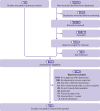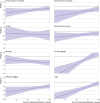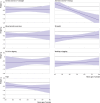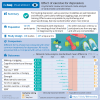Effect of exercise for depression: systematic review and network meta-analysis of randomised controlled trials
- PMID: 38355154
- PMCID: PMC10870815
- DOI: 10.1136/bmj-2023-075847
Effect of exercise for depression: systematic review and network meta-analysis of randomised controlled trials
Erratum in
-
Effect of exercise for depression: systematic review and network meta-analysis of randomised controlled trials.BMJ. 2024 May 28;385:q1024. doi: 10.1136/bmj.q1024. BMJ. 2024. PMID: 38806193 Free PMC article. No abstract available.
Abstract
Objective: To identify the optimal dose and modality of exercise for treating major depressive disorder, compared with psychotherapy, antidepressants, and control conditions.
Design: Systematic review and network meta-analysis.
Methods: Screening, data extraction, coding, and risk of bias assessment were performed independently and in duplicate. Bayesian arm based, multilevel network meta-analyses were performed for the primary analyses. Quality of the evidence for each arm was graded using the confidence in network meta-analysis (CINeMA) online tool.
Data sources: Cochrane Library, Medline, Embase, SPORTDiscus, and PsycINFO databases.
Eligibility criteria for selecting studies: Any randomised trial with exercise arms for participants meeting clinical cut-offs for major depression.
Results: 218 unique studies with a total of 495 arms and 14 170 participants were included. Compared with active controls (eg, usual care, placebo tablet), moderate reductions in depression were found for walking or jogging (n=1210, κ=51, Hedges' g -0.62, 95% credible interval -0.80 to -0.45), yoga (n=1047, κ=33, g -0.55, -0.73 to -0.36), strength training (n=643, κ=22, g -0.49, -0.69 to -0.29), mixed aerobic exercises (n=1286, κ=51, g -0.43, -0.61 to -0.24), and tai chi or qigong (n=343, κ=12, g -0.42, -0.65 to -0.21). The effects of exercise were proportional to the intensity prescribed. Strength training and yoga appeared to be the most acceptable modalities. Results appeared robust to publication bias, but only one study met the Cochrane criteria for low risk of bias. As a result, confidence in accordance with CINeMA was low for walking or jogging and very low for other treatments.
Conclusions: Exercise is an effective treatment for depression, with walking or jogging, yoga, and strength training more effective than other exercises, particularly when intense. Yoga and strength training were well tolerated compared with other treatments. Exercise appeared equally effective for people with and without comorbidities and with different baseline levels of depression. To mitigate expectancy effects, future studies could aim to blind participants and staff. These forms of exercise could be considered alongside psychotherapy and antidepressants as core treatments for depression.
Systematic review registration: PROSPERO CRD42018118040.
© Author(s) (or their employer(s)) 2019. Re-use permitted under CC BY-NC. No commercial re-use. See rights and permissions. Published by BMJ.
Conflict of interest statement
Competing interests: All authors have completed the ICMJE uniform disclosure form at www.icmje.org/disclosure-of-interest/ and declare: no support from any organisation for the submitted work; no financial relationships with any organisations that might have an interest in the submitted work in the previous three years; no other relationships or activities that could appear to have influenced the submitted work.
Figures









Comment in
-
Exercise for the treatment of depression.BMJ. 2024 Feb 14;384:q320. doi: 10.1136/bmj.q320. BMJ. 2024. PMID: 38355168 No abstract available.
-
The effect of exercise on suicide in people with depression.BMJ. 2024 Mar 12;384:q609. doi: 10.1136/bmj.q609. BMJ. 2024. PMID: 38471734 No abstract available.
-
Evidence based exercise prescriptions in primary care.BMJ. 2024 Mar 18;384:q617. doi: 10.1136/bmj.q617. BMJ. 2024. PMID: 38499300 No abstract available.
References
-
- World Health Organization. Depression. 2020 [cited 2020 Mar 12]. https://www.who.int/news-room/fact-sheets/detail/depression
-
- Birkjær M, Kaats M, Rubio A. Wellbeing adjusted life years: A universal metric to quantify the happiness return on investment. Happiness Research Institute; 2020. https://www.happinessresearchinstitute.com/waly-report
Publication types
MeSH terms
Substances
LinkOut - more resources
Full Text Sources
Medical
Research Materials
Miscellaneous
